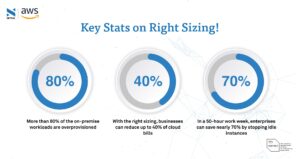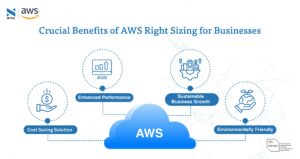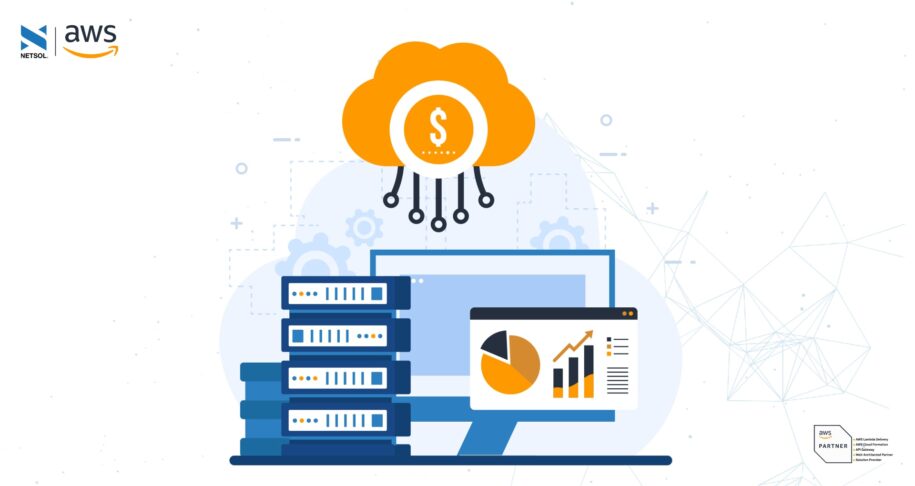Witnessing how businesses embrace cloud technology to drive their digital transformation is exciting. And COVID pandemic has undoubtedly accelerated this trend, and executives are recognizing the importance of having a robust cloud strategy in place. Instead of a fragmented approach, companies are now actively adopting a comprehensive end-to-end transformation approach centered around the cloud.
Today, Amazon Web Services (AWS) has become a pivotal aspect of cloud computing, offering a robust platform for businesses to expand and thrive. Companies can enjoy the power of unlimited data, which now poses a disadvantage to leading enterprises.
It often leads to higher cloud spending, and different business units incur complex costs. Effective cloud cost management is crucial to avoid complex AWS and cloud data management expenses. But due to high-end costs, managing these proves challenging as the AWS’ pricing model is highly complicated.
So, what’s the solution for it all? Right sizing AWS instances is the ultimate solution! Throughout this blog post, you will learn how AWS EC2 right sizing can control the gigantic genie of costs and effectively manage every aspect of the business.
Right Sizing – What’s This?
For many businesses, right sizing is still a new concept. They are seen complaining about the high AWS costs and how it’s drilling a hole in their bank accounts. They know little about right sizing and how it can save their valuable dollars in no time! So, what is AWS right sizing?
Understand the Concept of Right Sizing
The principle of right sizing is all about achieving a perfect balance between your computing needs and the resources you are currently using. In cloud computing, this usually involves virtual servers called instances that are used to run various applications. Many companies tend to overestimate their resource requirements during the initial stages of cloud migration to ensure optimal performance or accommodate future growth. Unfortunately, this often leads to unnecessary expenses due to unused or underutilized resources.
On the other hand, some companies may cut costs by underestimating what they need, leading to poor application performance and user experience. To overcome these inefficiencies, the right sizing helps to align resource allocation with actual utilization, ensuring both cost-effectiveness and optimal performance levels. Per the AWS experts, EC2 right sizing is a surefire way to optimize the cloud computing experience!
Key Stats!

Importance of AWS Right Sizing
To control cloud costs effectively, the right sizing is the way to go. This involves regularly analyzing instance performance and usage patterns and shutting down idle instances. Additionally, right sizing AWS instances that are overprovisioned or not matched well to the workload is essential. As resource needs change frequently, right sizing should be an ongoing process to continually optimize costs. Let’s learn some crucial benefits of AWS right sizing for businesses.

• Cost Saving Solution
By aligning resources with application demands, companies can avoid unnecessary expenses on unused or underutilized instances. Various studies reveal that continuously right sizing enterprises tend to pay 36% less than those running unoptimized instances. AWS right sizing is the way for businesses looking to optimize their resources and save some serious capital investment!
• Enhanced Performance
Optimizing costs and improving application performance are the benefits of right sizing. By allocating resources appropriately, applications run more efficiently, resulting in faster response times and better user experiences.
• Sustainable Business Growth
Right Sizing AWS empowers your business to adapt its cloud resources and effortlessly meet scaling or demand changes. This unparalleled flexibility guarantees managing growth without overspending or affecting performance.
• Environmentally Friendly
Right Sizing is a fantastic process that aligns with sustainability and environmental responsibility values. This technique optimizes resource utilization, thereby reducing energy consumption and carbon footprint while running cloud applications. It’s a win-win situation for everyone involved!
Still not convinced regarding the benefits of AWS Right Sizing? Check out our blog post, “Importance of Right Sizing Before Cloud Migration,” to know about it in detail!
How to Implement Effective Right Sizing Strategies?
Are you looking to optimize your AWS EC2 instances for cost savings and better performance? Right-sizing is the answer!
You can efficiently allocate CPU, memory, and storage resources to meet your workload requirements while minimizing costs. This involves adjusting instance size, selecting the right instance family, utilizing autoscaling, and optimizing storage options. When you right-size your infrastructure, you can expect improved reliability, performance, and reduced costs. Businesses need to prioritize cloud infrastructure management and optimization. But how? Let’s explore!

Analyze Performance Data
First and foremost, the most critical strategy is to analyze, explore, and react. Therefore, you can identify idle or underutilized EC2 instances by analyzing performance data. Some key points to remember include:
- Key metrics like CPU and memory usage can help pinpoint instances with less than 40% maximum usage over four weeks.
- For compute-optimized instances, you must focus on recent data and those that have run for at least half the time.
- Ignore burstable instance families, which are solely designed to run at low CPU percentages.
- IOPS is the metric to watch for storage-optimized instances and tailor the reports to each instance type.
- Per AWS right sizing recommendations, you must convert NetworkIn and NetworkOut values to Mbps using the formula:
- Maximum NetworkIn (or NetworkOut) x 8 (bytes to bits) /1024/1024/ 60 = Number of Mbps
- Closely monitor I/O and CPU percentage metrics throughout the day to accommodate peaks.
- If maximum memory utilization is less than 40%, you can right size against memory.
Now don’t forget about Amazon RDS DB instances! Focus on metrics like CPU utilization, available RAM, and bytes read/written per second to determine if actual usage is lower than capacity.
Right Size Per Usage Needs
You can maximize your performance monitoring by identifying usage needs and patterns. Here are some common usage patterns and our suggestions on how to optimize for each:
- Steady State – Are you dealing with a load that remains constant over time? Great! You can accurately forecast the compute load using Reserved Instances and save on costs.
- Variable but Predictable – Do you experience predictable load changes, such as hourly, daily, or weekly? AWS Auto Scaling is your perfect solution! This feature will enable you to scale Amazon EC2 capacity up or down as needed to handle spikes in traffic or predictable fluctuations.
- Dev/Test/Production – If you only use development, testing, and production environments during business hours, you can save costs by turning them off during evenings, weekends, and holidays. You’ll save big by simply using tagging to identify these instances!
- Temporary – What about temporary workloads with flexible start times that can be interrupted? Consider using Amazon EC2 Spot Instances instead of On-Demand Instances. Place a bid for these instances to save on costs.
These suggestions will help you optimize your performance monitoring and save you some serious capital.
Say Good Bye to Idle Instances
You can also cut down on operational costs! You can save money on your cloud computing expenses by turning off existing unused instances. If an instance has been idle for more than two weeks, it is generally safe to stop or terminate it, but there are a few questions you should consider before doing so. Ask yourself who owns the instance, the potential consequences of terminating it, and how difficult it would be to recreate it in the future if necessary.
If you choose to stop an EC2 instance, remember that any attached EBS volumes will still be active and billed until they are deleted. On the other hand, discontinuing an instance will automatically delete any attached EBS volumes and require additional effort to re-provision if needed later. If you decide to delete an EBS volume, take a snapshot first to restore it later if necessary.
Here’s another tip: consider stopping development or production instances during periods of non-use and then restarting them when needed. By doing this during non-business hours, you can save up to 70% of your costs! Luckily, several tools are available for automating scheduling, such as Amazon EC2 Scheduler, AWS Lambda, and AWS Data Pipeline, as well as third-party options like CloudHealth and Skeddly.
By following these right sizing AWS instances steps, you can save money and optimize your cloud computing resources.
Select Right Instance Family, only!
You can either switch to a different model within the same instance family or move to another instance family altogether to adjust the size of your EC2 instance. If you’re staying within the same family, you’ll only need to consider factors such as vCPU, memory, network throughput, and ephemeral storage.
Here’s a handy tip: if the maximum CPU and memory usage is lower than 40% for four weeks, you can safely reduce the size of your machine by half. For example, if you previously used a c4.8xlarge EC2, you could move to a c4.4xlarge and save $190 every 10 days.
Migration to Different Instance Family
If you’re migrating to a different instance family, ensuring that the current and new instance types are compatible regarding virtualization type, network, and platform is essential. For example, the instances should have the same Linux AMI virtualization type, including PV AMI versus HVM and platform (EC2-Classic versus EC2-VPC). Additionally, some instances are unsupported in the EC2-Classic and should be launched in a virtual private cloud (VPC).
Tips & Tricks
It’s also worth noting that if your current instance type supports 32-bit AMIs, select a new instance type that also supports 32-bit AMIs. You can quickly check the platform of your instance by navigating to the Instances screen in the Amazon EC2 console and selecting Show/Hide Columns, Architecture.
Lastly, it’s vital to remember that when you resize an EC2 instance, the resized instance mostly has the same number of instance store volumes specified when you launched the original instance. However, it’s important to note that you cannot attach instance store volumes to an instance after you’ve launched it. If you want to add instance store volumes, you’ll need to migrate to a new instance type with more volumes.
Right Size the Database Instances
You can effortlessly adjust your memory or compute power up or down to accommodate any changes in performance and capacity requirements. It’s important to note that when you scale your database instance, your storage size remains constant and is not affected by the change.
To further improve your performance or increase the allocated storage space, you can modify your Amazon RDS DB instance separately by changing the storage type to Provisioned IOPS SSD or General Purpose SSD.
It’s essential to ensure you have the correct licensing for commercial engines like SQL Server or Oracle, particularly if you Bring Your Own License (BYOL). You can apply any changes immediately with flexibility or during the specified maintenance window.
AWS Right Sizing – The Ultimate Power Tool for Efficient Cloud Resource Management
Optimizing your cloud infrastructure without compromising performance is crucial for businesses seeking cost-effective cloud resource management. AWS Right Sizing empowers organizations to achieve this by matching resources to application demands, reducing costs, improving application performance, and promoting sustainable growth. As cloud technology continues to evolve, AWS EC2 Right Sizing remains a crucial strategy for maximizing the benefits of AWS while maintaining fiscal responsibility. Embrace the power of Right Sizing AWS and unlock the true potential of your cloud environment today with NETSOL. Contact us today and ensure no under provisioned or over provisioned instance is wasting your money.



Leave a Reply